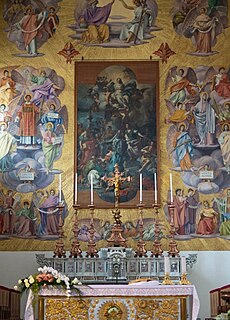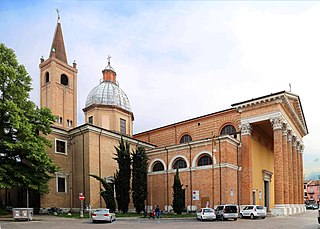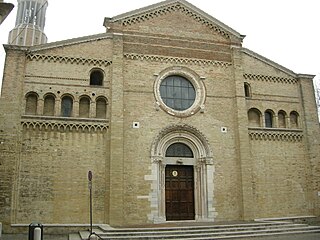Related Research Articles

The Archdiocese of Florence is a metropolitan see of the Catholic Church in Italy. It was traditionally founded in the 1st century, according to the 14th century chronicler Giovanni Villani. The diocese was directly subordinate to the Holy See (Papacy) until 1420.

The Roman Catholic Archdiocese of Capua is an archdiocese of the Roman Catholic Church in Capua, in Campania, Italy, but its archbishop no longer holds metropolitan rank and has no ecclesiastical province. Since 1979, it is a suffragan of the Archdiocese of Napoli, i.e. no longer has its own ecclesiastical province nor metropolitan status.

The Diocese of Rimini is a Latin Church ecclesiastical territory or diocese of the Catholic Church in Emilia Romagna, Italy. From earliest times, it was a suffragan to the Holy See, despite repeated attempts by the Diocese of Ravenna to claim it as a suffragan diocese. Since 1604, however, it has been a suffragan of the Archdiocese of Ravenna-Cervia.

The Roman Catholic diocese of Ferentino existed until 1986, when it was united into the new diocese of Frosinone-Veroli-Ferentino.

The Diocese of Frosinone-Veroli-Ferentino(Latin: Dioecesis Frusinatensis-Verulana-Ferentina) is a Latin Church ecclesiastical territory or diocese of the Catholic Church in Italy. It has existed since 1986. In that year, the Diocese of Ferentino was united into the Diocese of Veroli-Frosinone, which was the name of the historic Diocese of Veroli from 1956. It is immediately exempt to the Holy See and not part of an ecclesiastical province.

The Diocese of Rieti is a Latin Church ecclesiastical territory or diocese of the Catholic Church in Italy. It is immediately exempt to the Holy See. Its cathedra is in St. Mary Cathedral in the episcopal see of Rieti.

The Diocese of Grosseto is a Roman Catholic ecclesiastical territory in Italy, a suffragan of the archdiocese of Siena-Colle di Val d'Elsa-Montalcino, in Tuscany. Its current bishop is Giovanni Roncari, OFMCap.

The Archdiocese of Siena-Colle di Val d'Elsa-Montalcino is a Roman Catholic archdiocese in Tuscany. The seat of the archbishop is the Cathedral of the Assumption in Siena. Until 1459, the diocese was immediately subject to the Holy See (Papacy), and its bishops attended the Roman synods. In 1459, Pope Pius II made Siena a metropolitan archbishopric.

The Diocese of Tolentino was a Roman Catholic diocese in Italy in the fifth century and early sixth century. The name of the diocese was revived, and its territory added to the Diocese of Macerata-Tolentino in 1586 by Pope Sixtus V.

The Archdiocese of Pisa is a metropolitan see of the Catholic Church in Pisa, Italy. It was founded in the 4th century and elevated to the dignity of an archdiocese on 21 April 1092 by Pope Urban II. The seat of the bishop is the cathedral of the Assumption in the Piazza del Duomo.

The Italian Catholic diocese of Todi existed until 1986, when it was united into the diocese of Orvieto-Todi. Up until that point, the diocese had always been directly dependent on the Holy See.

The Diocese of Orvieto-Todi is a Latin Church ecclesiastical territory or diocese of the Catholic Church in central Italy. It was created in 1986 when the historical Diocese of Orvieto was united to the Diocese of Todi. The Diocese of Orvieto-Todi is immediately exempt to the Holy See and not part of any ecclesiastical province.

The Diocese of Forlì-Bertinoro is a Roman Catholic ecclesiastical territory in Romagna, Italy. Until 1986 it was known as the Diocese of Forlì, in existence perhaps from the fourth century. In that year the Diocese of Bertinoro was united to it. The diocese is suffragan to the Archdiocese of Ravenna-Cervia.

The Italian Catholic Diocese of Gubbio is in the province of Perugia, in Umbria, central Italy.

The Italian Catholic Diocese of Pistoia is located in the Province of Florence. It has existed since the third century. From 1653 to 1954, the historic diocese was the diocese of Pistoia and Prato. The Diocese of Prato has been separate from 1954. The diocese is a suffragan of the archdiocese of Florence.

The Diocese of Fano-Fossombrone-Cagli-Pergola is a Roman Catholic ecclesiastical territory in Italy, created in 1986, when the historical Diocese of Fano was united to the Diocese of Cagli e Pergola and the Diocese of Fossombrone. It is a suffragan of the Archdiocese of Pesaro.

The Italian Catholic Diocese of Cesena-Sarsina in Emilia Romagna was created on September 30, 1986, after the Diocese of Sarsina was united with the historic Diocese of Cesena as a suffragan of the Archdiocese of Ravenna-Cervia.

The Diocese of Anagni-Alatri is a Latin Church ecclesiastical territory or diocese of the Catholic Church in Lazio, Italy. It has existed in its current form since 1986. In that year the Diocese of Alatri was united to the historical Diocese of Anagni. The diocese is immediately exempt to the Holy See.

The Diocese of Civitavecchia-Tarquinia is a Latin Church ecclesiastical territory or diocese of the Catholic Church in Lazio, Italy. It was established under this name in 1986. The diocese is immediately exempt to the Holy See and not part of an ecclesiastical province.

The former Italian Catholic Diocese of Chiusi-Pienza, in Tuscany, existed until 1986. In that year it was united into the Diocese of Montepulciano-Chiusi-Pienza. The Diocese of Chiusi (Clusinus) was at first immediately subject to the Holy See, but was made a suffragan of archdiocese of Siena by Pope Pius II. From 1459 to 1986, it was a suffragan of the archdiocese of Siena.
References
- ↑ Kehr, Italia pontificia II, p. 196: "Quod autem ad Tuscaniam attinet, certe iam saec. VII sedes episcopalis...."
- ↑ Louis Duchesne, "Les évêchés d'Italie et l'invasion lombarde," Mélanges d'archéologie et d'histoire 23 (Paris: Fontemoing 1903), pp. 89-90.
- ↑ Kehr, p. 196.
- ↑ Campanari, I, pp. 114-115; II, pp. 92-108.
- ↑ Cappelletti, pp. 80-87. Signorelli, Viterbo nella storia, pp. 68-78 (dating the bull to 850 rather than 852.
- ↑ Paul Fridolin Kehr points out that Cardinal Joannes of S. Clemente signs himself "Tuscanensis episcopus" until August 1192, and then from 4 October 1192 signs himself "Viterbiensis et Tuscanensis episcopus. Kehr, Italia pontificia II, p. 208.
- ↑ David M. Cheney. Catholic-Hierarchy.org . "Diocese of Toscanella (Tuscania)" Catholic-Hierarchy.org . David M. Cheney. Retrieved October 7, 2016.[ self-published source ]
- ↑ Gabriel Chow.GCatholic.org. "Titular Episcopal See of Tuscania" Retrieved October 7, 2016.[ self-published source ]
- ↑ Lanzoni, p. 527, who notes that Ughelli (Italia sacra X, p. 180) wrongly calls him "Urbanus". Bishop Virbonus was present at the Roman synod of Pope Gregory I on 5 July 595. Cappelletti, Chiese d'Italia VI, p. 78.
- ↑ Bishop Maurus was present at the Roman synod of Pope Martin I in October 649. J.D. Mansi (ed.), Sacrorum Conciliorum nova et amplissima collectio, editio novissima, Tomus X, p. 867. Cappelletti, p. 78.
- ↑ Campanari, II, p. 20, says that Bishop Vitalianus subscribed a letter of Pope Agatho to the Sixth Council of Constantinople.
- ↑ Bishop Aurianus (Orinandus) attended the Roman synod of Pope Stephen III in April 1769. J.D. Mansi (ed.), Sacrorum Conciliorum nova et amplissima collectio, editio novissima, Tomus XII, p. 715. Cappelletti, p. 79.
- ↑ Bishop Godemundus attended the Roman synod of Pope Eugenius II on 15 November 826. J.D. Mansi (ed.), Sacrorum Conciliorum nova et amplissima collectio, editio novissima, Tomus XIV, p. 1000. Ughelli, X, p. 180.
- ↑ Pope Leo IV confirmed the properties of the Church of Tuscania for Bishop Virbonus on 22 February 852. Campanari, II, pp. 21, 92-108.
- ↑ In 876, Bishop Joannes was sent by Pope John VIII as papal Legate to the Council of Pontoise. J.D. Mansi (ed.), Sacrorum Conciliorum nova et amplissima collectio, editio novissima, Tomus XVII, p. 307-310. Campanari, II, pp. 21-22.
- ↑ Bishop Joannes attended the Roman synod of 6 April 1027. Schwartz, p. 265.
- ↑ In November 1037, Bonizo signed a document of Pope Benedict IX as "presbyter et vicedominus S. Rufinae et designatus gratia dei episcopus Tuscanensis". In April 1044 he attended a Roman synod of Benedict IX. Schwartz, p. 265.
- ↑ On 22 April 1049 he had already been appointed Bishop of Porto by Benedict IX. Schwartz, p. 265.
- ↑ In 1049 Bishop Benedictus attended the Roman synod of Pope Leo IX. Schwartz, p. 256.
- ↑ Bishop Bonizo attended the Roman synod of Pope Leo IX on 29 April 1050. J.D. Mansi (ed.), Sacrorum Conciliorum nova et amplissima collectio, editio novissima, Tomus XIX, p. 771. Schwartz, p. 256.
- ↑ On 13 April 1059 Bishop Gisilbertus was present at the Roman synod of Pope Nicholas II. On 26 March 1280, he subscribed a grant for the abbot of Farfa. Schwartz, pp. 256-257.
- ↑ Riccardus; Campanari, II, pp. 109-112 (September 1086). Gams, p. 737 column 1.
- ↑ Guido: Kehr, II, p. 197, no. 3. Schwartz, pp. 266-267.
- ↑ Bishop Petrus was present at the Roman council of Pope Honorius II in 1126. J.D. Mansi (ed.), Sacrorum Conciliorum nova et amplissima collectio, editio novissima, Tomus XXI, p. 345. Cappelletti, p. 95.
- ↑ Signorelli, p. 123, with notes 27 and 28. Signorelli states that Bishop Nicolaus was present at the Second Lateran Council of Pope Innocent II, which took place in April 1139. His citations do not support his claim. Cappelletti, p. 95, does not mention his presence.
- ↑ Signorelli, p. 123, with note 29. Neither Cappelletti nor Gams include a Bishop Ludovicus in their lists. But see the document of 1142 in Campanari, II, p. 116.
- ↑ Rodolfus: Campanari, II, p. 117. Signorelli, p. 123, with notes 30 and 31.
- ↑ Bishop Censius (Gentius, Centius) was present at the Third Lateran Council of Pope Alexander III in 1179. J.D. Mansi (ed.), Sacrorum Conciliorum nova et amplissima collectio, editio novissima, Tomus XXII, p. 459. Cappelletti, p. 96. Gams, p. 737 column 1. Signorelli, p. 131 with note 10.
- ↑ Gottfredus: Gams, p. 737 column 1.
- ↑ Cardinal Joannes was Bishop of Tuscanella from 1188 to 1192, when Toscanella was united with Viterbo; he was then Bishop of Viterbo e Toscanella. He had been named Cardinal-Priest of S. Clemente in 1189, and was promoted Cardinal-Bishop of Albano in 1199. He died in 1210. Gams, p. 737 col. 1. Cappelletti, pp. 96-107. Conradus Eubel (1913). Hierarchia catholica (in Latin). Vol. Tomus I (second ed.). Münster: Libreria Regensbergiana. p. 3 note 1, no. 7.